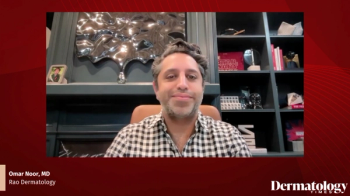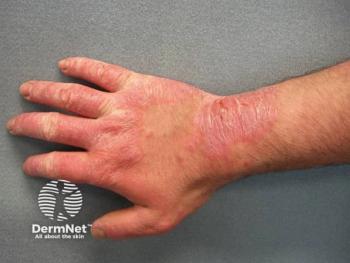
- Dermatology Times, September 2025 (Vol. 46. No. 09)
- Volume 46
- Issue 09
Split-Face Study Reveals New Role for BoNT-A
Key Takeaways
- BoNT-A may inhibit melanogenesis and reduce inflammation, offering a novel approach to melasma treatment.
- A split-face trial showed BoNT-A combined with TCC improved melasma outcomes and reduced recurrence.
Patients receiving BoNT-A plus topical cream reported greater satisfaction and better skin lightness than with cream alone.
Melasma has long challenged clinicians with its stubborn persistence, frustrating recurrence, and limited treatment success. Characterized by symmetrical brown or gray-brown patches on the face, this acquired hyperpigmentary disorder is most common in individuals with Fitzpatrick skin types III–V and is particularly prevalent among Asian, Middle Eastern, Mediterranean, and Hispanic populations. While the cosmetic burden is clear, the therapeutic path forward often isn't.1
Now, a growing body of evidence suggests a surprising contender may be poised to change that: botulinum toxin A (BoNT-A). Best known for smoothing wrinkles, BoNT-A may also help fade pigmentation—and keep it from returning.2
A recent randomized, split-face clinical trial conducted at Ramathibodi Hospital in Bangkok puts this theory to the test. Investigators explored whether intradermal injections of incobotulinum toxin A (incoBoNT-A; Xeomin) could boost the effects of a triple combination cream (TCC) in melasma management—and possibly prevent its all-too-common recurrence.3
In a recent conversation with Dermatology Times, Zoe Diana Draelos, MD, a consulting professor of dermatology at Duke University School of Medicine in Durham, North Carolina, and Dermatology Times’ editor in chief emeritus, had this to say on the topic: “Botulinum toxin A injections for dyspigmentation is an interesting concept in need of larger controlled monotherapy clinical trials for further assessment.”
A New Role for a Familiar Toxin
BoNT-A is widely used in aesthetic and neuromuscular medicine. But studies in recent years have hinted at a broader role: inhibiting melanogenesis by interfering with acetylcholine signaling, dampening UV-induced inflammation, and modulating the dermal microenvironment. In human studies, incidental skin lightening was observed following facial injections for cosmetic use. 2,4
Study Design
Thirty female patients with mixed-type, symmetrical melasma were enrolled. Each participant applied a standard TCC (hydroquinone 4%, tretinoin 0.05%, fluocinolone acetonide 0.01%) nightly for 12 weeks. On 1 side of the face, this regimen was paired with intradermal incoBoNT-A injections administered at baseline and week 12. The other side served as a control (TCC monotherapy).
Outcomes were assessed via the modified Melasma Area and Severity Index (MASIm), colorimetric analysis (CIE L* values), and patient satisfaction scores. Standardized photographs were also reviewed, and follow-up extended to 24 weeks.
Results
The findings were striking. The BoNT-A plus TCC combination achieved greater MASIm reduction than TCC alone—starting as early as week 2 (p = 0.0032). At week 4, the combination side showed a 20.41% improvement, while the monotherapy side slightly worsened.
Perhaps even more compelling was what happened after stopping topical treatment at week 12. Researchers found theBoNT-A-treated side continued to improve, with theMASIm dropping to 9.14 at week 24. The control side, meanwhile, rebounded to aMASIm of 14.79. This suggestsBoNT-A may not only enhance short-term treatment response but also help prevent melasma relapse—a major unmet need in clinical practice.
Researchers found that patients felt the difference, too. On a 10-point satisfaction scale, participants rated the BoNT-A side significantly higher at the end of the study (8.92 vs. 7.04, p < 0.0001).
Mechanisms: More Than Just Muscle
Emerging research suggests BoNT-A may inhibit melanin synthesis by blocking acetylcholine release from melanocytes. Acetylcholine is known to trigger melanin production via muscarinic receptors. By interfering with this pathway, BoNT-A may dial down melanocyte activity.
It also appears to reduce the release of pro-inflammatory cytokines and neuropeptides such as substance P and CGRP—agents involved in UV-induced inflammation and vasodilation. These pathways are increasingly recognized in the vascular and inflammatory dimensions of melasma pathogenesis, highlighting BoNT-A’s multi-targeted potential.5
Safety and Practical Considerations
No serious adverse events occurred during the study. Researchers noted mild swelling and redness at injection sites resolved within a few days. Importantly, no facial asymmetry or muscle weakness was observed—an encouraging sign for a procedure involving facial injections.
Because incoBoNT-A is a purified formulation lacking complexing proteins, it may also pose a lower risk for antibody development—especially important if repeat treatments are considered in the future.
However, as with any new approach, questions remain. The study noted the sample size was relatively small, and longer-term outcomes beyond 24 weeks are still unknown. Additional research should explore how BoNT-A compares to other adjunctive treatments, such as oral tranexamic acid or laser therapy, and how frequently repeat injections might be needed.
Conclusion
Melasma remains one of dermatology’s most frustrating pigmentary disorders. For patients and clinicians alike, the constant cycle of improvement and relapse can be exhausting. This study offers new hope. By pairing standard topical therapy with incoBoNT-A, clinicians may be able to offer patients faster improvement, longer remission, and greater satisfaction—with a low adverse effect burden.
“Melasma remains a challenging condition to treat for a variety of reasons and there remains a need for additional treatment options that can target the various etiologies and stages of pathogenesis of the condition including those involved in melanogenesis, inflammation, and angiogenesis. The investigation of botulinum toxin A is of interest given its possible effects on both melanogenesis and cutaneous vasculature, the latter of which has less treatment options at this time,” Nada Elbuluk, MD, MSc, FAAD, professor of clinical dermatology and founding director of the skin of color and pigmentary disorders program at USC Keck School of Medicine, told Dermatology Times. “More studies are needed to understand if it can play a potential role in the treatment of melasma as well as to understand the dosing, safety, and efficacy of it. It would be helpful for further studies to also evaluate the effects of botulinum toxin A as a monotherapy and see how it compares to placebo to better understand its potential role in the treatment algorithm of melasma.”
As our understanding of BoNT-A’s anti-pigmentary mechanisms deepens, it’s possible that this familiar neurotoxin will find a new niche—not just in aesthetics, but as a valuable therapeutic tool in the fight against melasma. Further research is warranted, but the message is clear: this is a treatment avenue worth watching.
References
- Ogbechie-Godec OA, Elbuluk N. Melasma: An up-to-date comprehensive review. Dermatol Ther (Heidelb). 2017;7(3):305-318. doi:10.1007/s13555-017-0194-1
- Jung JA, Kim BJ, Kim MS, et al. Protective effect of botulinum toxin against ultraviolet-induced skin pigmentation. Plast Reconstr Surg. 2019;144(2):347-356. doi:10.1097/PRS.0000000000005838
- Chaijaras S, Boonpethkaew S, Chirasuthat S, Sakpuwadol N, Yongpisarn T, Anansiripun P, Vachiramon V. Efficacy of botulinum toxin A for the management of melasma: A split-face, randomized control study. J Cosmet Dermatol. 2025 Aug;24(8):e70376. doi: 10.1111/jocd.70376. PMID: 40747795; PMCID: PMC12315078.
- Martina E, Diotallevi F, Radi G, Campanati A, Offidani A. Therapeutic use of botulinum neurotoxins in dermatology: Systematic review. Toxins (Basel). 2021;13(2):120. Published 2021 Feb 5. doi:10.3390/toxins13020120
- Kwon SH, Hwang YJ, Lee SK, Park KC. Heterogeneous pathology of melasma and Its clinical implications. Int J Mol Sci. 2016;17(6):824. Published 2016 May 26. doi:10.3390/ijms17060824
Articles in this issue
2 months ago
Dermatology Times September 2025 Print Recap2 months ago
Cosmeceutical Myths3 months ago
Research-Inspired Tips From DERM 20253 months ago
Balancing Cure and Cosmesis in Mohs SurgeryNewsletter
Like what you’re reading? Subscribe to Dermatology Times for weekly updates on therapies, innovations, and real-world practice tips.



















